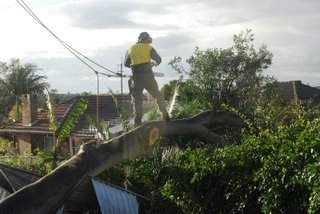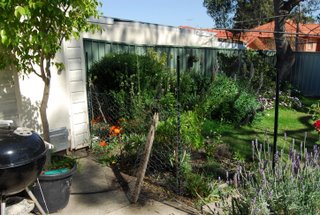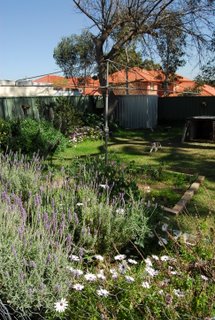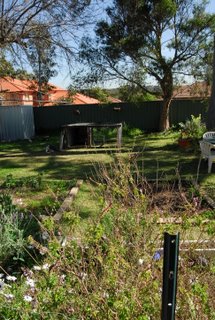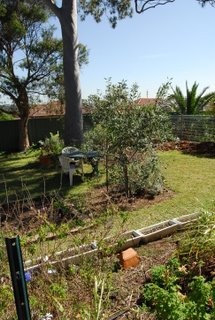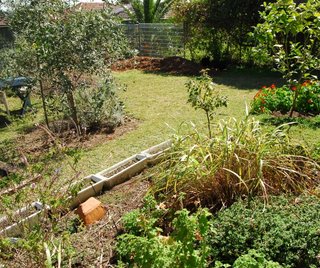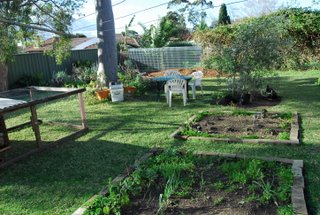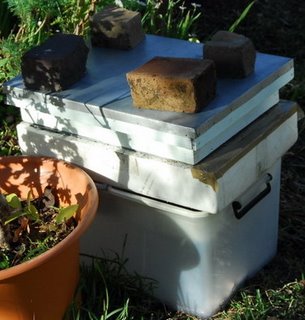Pets and Trees
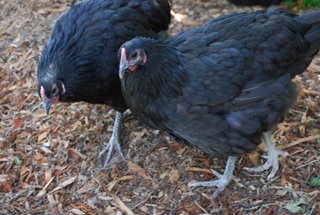 Our 2 new chickens arrived in a cardboard box from Chicks'R'Us hatchery on 31 August. They were 20 weeks old, at which time they're known as 'point-of-lay', although they're not laying yet. We named them Arabella and Beyonce. Beyonce might actually be slightly younger, and she is shy, scared and tends to follow Arabella around everywhere. When separated they cheep cheep cheep for each other or panic and bok bok bok. Arabella is missing a lot of tail feathers and has darker legs than Beyonce so they're easy enough to tell apart.
Our 2 new chickens arrived in a cardboard box from Chicks'R'Us hatchery on 31 August. They were 20 weeks old, at which time they're known as 'point-of-lay', although they're not laying yet. We named them Arabella and Beyonce. Beyonce might actually be slightly younger, and she is shy, scared and tends to follow Arabella around everywhere. When separated they cheep cheep cheep for each other or panic and bok bok bok. Arabella is missing a lot of tail feathers and has darker legs than Beyonce so they're easy enough to tell apart.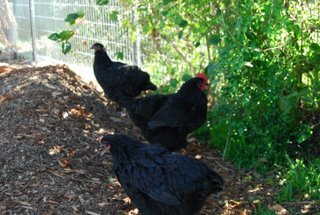 Coco (standing in the middle with the bright red combe) was the first chicken we got - she is much older (about 3 1/2 years, although we've only had her since 9 July) and this year she started laying on 31 July. She lays 2 out of every 3 days approximately and her eggs have bright orange yolks.
Coco (standing in the middle with the bright red combe) was the first chicken we got - she is much older (about 3 1/2 years, although we've only had her since 9 July) and this year she started laying on 31 July. She lays 2 out of every 3 days approximately and her eggs have bright orange yolks.Arabella has become pretty friendly with Coco and while Coco has established herself as first in the pecking order, Arabella is definitely second while poor Beyonce is at the bottom. Arabella is always seen scaring other 'visiting' birds such as crows, magpies, cockatoos, pigeons and indian miners away, and we joke that she must have been assigned that duty by Coco.

Stretchhhh.
Here is their home, the chicken-coop.
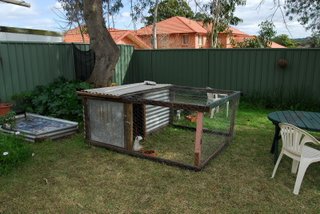
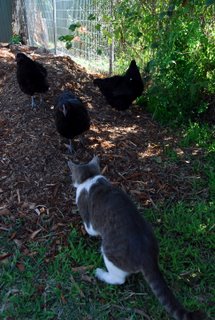
Our four pets!
Ezekiel is our cat. He and Coco are best mates. They even slept a night in the same room, Ezekiel's house. It was Coco's doing - I went down to make sure she was in bed, couldn't see her anywhere, I heard a bgok, looked up and there she was, 2nd shelf up in Ezekiel's room (our old downstairs toilet). I tried to put him in the chicken coop for the night because I couldn't move Coco, but he broke out, of course, and turned up later at our front door. So for lack of places for him to spend the night he went in with her, and after observing them carefully for an hour or two and after having seen them in the yard for the last 2 weeks with Ezekiel more scared of Coco than anything, they spent 7 hours together in close quarters.
That was a bizarre night on the 21 July. I checked on them during the night, then the next morning after letting them out was the morning our old Eucalyptus tree came crashing down. We initially just thought the crashing noise was from a truck or something down the street, then an hour or so later looked out the window and saw this:
 The insurance company sent out their contractors the same day around 2pm and they had it cleaned up by 5.30pm. They took all of our old junk from the shed away too, as well as coming back later to deliver 2 cubic metres of mulch and grinding the stump of the tree into sawdust - useful for my compost, and they gave us a new shed. We now have soo much more sun in the yard, and since it was all fixed up so quickly and only damaged the neighbour's washing line and our old shed, I almost didn't mind! The leaves of the tree took up our neighbour's entire backyard!
The insurance company sent out their contractors the same day around 2pm and they had it cleaned up by 5.30pm. They took all of our old junk from the shed away too, as well as coming back later to deliver 2 cubic metres of mulch and grinding the stump of the tree into sawdust - useful for my compost, and they gave us a new shed. We now have soo much more sun in the yard, and since it was all fixed up so quickly and only damaged the neighbour's washing line and our old shed, I almost didn't mind! The leaves of the tree took up our neighbour's entire backyard!Here they are chopping it down, fearlessly!
